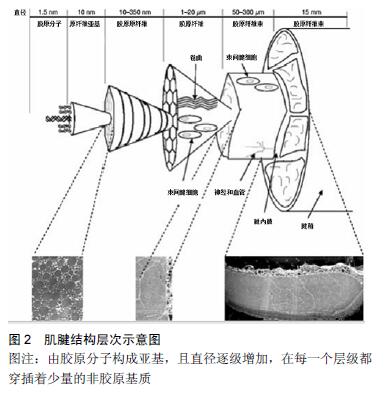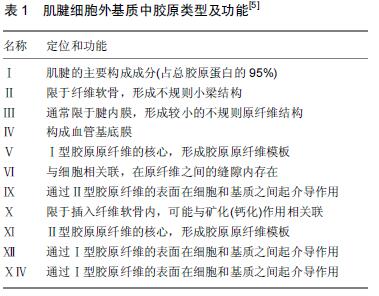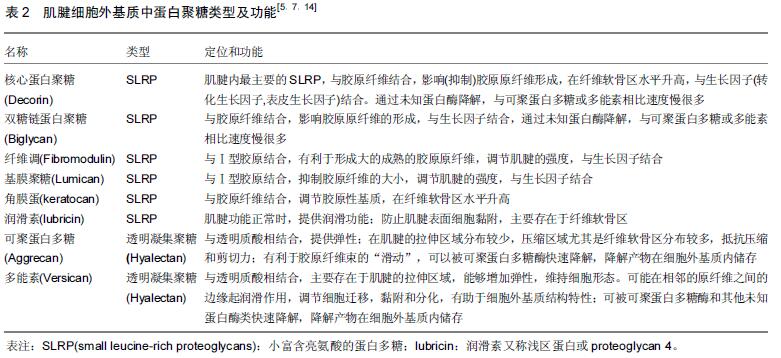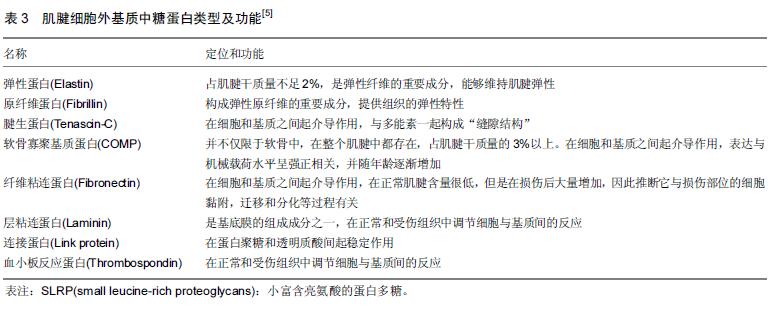[2] Hashimoto Y, Yoshida G, Toyoda H, et al. Generation of tendon-to-bone interface enthesis with use of recombinant BMP-2 in a rabbit model. J Orthop Res. 2007;25(11):1415-1424.
[3] Riley G.The pathogenesis of tendinopathy.a molecular perspective. Rheumatology (Oxford). 2004;43(2):131-142.
[4] (美)古德曼. 西氏内科学[M].世界图书北京出版公司, 2009.
[5] Thorpe CT, Birch HL, Clegg PD, et al. The role of the non-collagenous matrix in tendon function. Int J Exp Pathol.2013;94(4):248-259.
[6] Banos CC, Thomas AH, Kuo CK.Collagen fibrillogenesis in tendon development: current models and regulation of fibril assembly. Birth Defects Res C Embryo Today. 2008;84(3):228-244.
[7] Rees SG, Dent CM, Caterson B. Metabolism of proteoglycans in tendon. Scandinavian Journal of Medicine and Science in Sports.2009, 19(4): 470-478.
[8] Magnusson SP, Qvortrup K, Larsen JO, et al. Collagen fibril size and crimp morphology in ruptured and intact Achilles tendons. Matrix Biol. 2002;21(4): 369-377.
[9] Lui PP, Chan LS, Lee YW, et al. Sustained expression of proteoglycans and collagen type III/type I ratio in a calcified tendinopathy model. Rheumatology (Oxford). 2010 ;49(2):231-239.
[10] Danielson P, Alfredson H, Forsgren S.Studies on the importance of sympathetic innervation, adrenergic receptors, and a possible local catecholamine production in the development of patellar tendinopathy (tendinosis) in man. Microsc Res Tech. 2007;70(4):310-324.
[11] Archambault JM, Hart DA, Herzog W. Response of rabbit Achilles tendon to chronic repetitive loading. Connect Tissue Res. 2001;42(1):13-23.
[12] Birch HL.Tendon matrix composition and turnover in relation to functional requirements. Int J Exp Pathol. 2007;88(4):241-248.
[13] Handley C, Parkinson J, Samiric T, et al. Overuse tendinopathy is characterised by changes in the metabolism of proteoglycans present in the extracellular matrix of tendons. Journal of Science and Medicine in Sport.2010;Suppl 1): e21-e2.
[14] Yoon JH, Halper J.Tendon proteoglycans: biochemistry and function. J Musculoskelet Neuronal Interact. 2005; 5(1):22-34.
[15] Burssens A, Forsyth R, Bongaerts W,et al.Arguments for an increasing differentiation towards fibrocartilaginous components in midportion Achilles tendinopathy. Knee Surgery. Knee Surg Sports Traumatol Arthrosc. 2013;21(6):1459-1467.
[16] Corps AN, Robinson AH, Movin T, et al.Increased expression of aggrecan and biglycan mRNA in Achilles tendinopathy. Rheumatology.2006;No.3): 291-294.
[17] Mazzocca AD, McCarthy MB, Ledgard FA,et al. Histomorphologic Changes of the Long Head of the Biceps Tendon in Common Shoulder Pathologies. Arthroscopy. 2013;29(6):972-981.
[18] Attia M, Scott A, Carpentier G, et al.Greater glycosaminoglycan content in human patellar tendon biopsies is associated with more pain and a lower VISA score. Br J Sports Med.2014; No.6): 469-475.
[19] Samiric T, Parkinson J, Ilic MZ, et al.Changes in the composition of the extracellular matrix in patellar tendinopathy. Matrix Biology.2009;No.4): 230-236.
[20] Scott A, Lian Ø, Roberts CR,et al.Increased versican content is associated with tendinosis pathology in the patellar tendon of athletes with jumper''s knee. Scand J Med Sci Sports. 2008 ;18(4):427-35.
[21] Corps AN, Robinson AH, Movin T, et al.Versican splice variant messenger RNA expression in normal human Achilles tendon and tendinopathies. Rheumatology (Oxford). 2004;43(8):969-972.
[22] Gosline J, Lillie M, Carrington E, et al. Elastic proteins: biological roles and mechanical properties. Philos Trans R Soc Lond B Biol Sci. 2002;357(1418):121-132.
[23] Lillie MA, Gosline JM.The viscoelastic basis for the tensile strength of elastin. Int J Biol Macromol. 2002; 30(2):119-127.
[24] Kostrominova TY, Brooks SV. Age-related changes in structure and extracellular matrix protein expression levels in rat tendons. Age (Dordr). 2013;35(6): 2203-2214.
[25] Andersson T, Eliasson P, Aspenberg P.Rat Achilles tendon healing: mechanical loading and gene expression. Int J Sports Med. 2012;33(3):240-407.
[26] Chiquet-Ehrismann R, Tucker RP.Connective tissues: signalling by tenascins. Int J Biochem Cell Biol. 2004; 36(6):1085-1089.
[27] J P, U F, K Q, et al.Local biochemical and morphological differences in human Achilles tendinopathy: a case control study. BMC Musculoskelet Disord. 2012;13:53.
[28] Chang J, Thunder R, Most D, et al. Studies in Flexor Tendon Wound Healing: Neutralizing Antibody to TGF-[beta]1 Increases Postoperative Range of Motion. Plast Reconstr Surg. 2000;105(1):148-155.
[29] Jaibaji M.Advances in the Biology of Zone II Flexor Tendon Healing and Adhesion Formation. Ann Plast Surg. 2000 Jul;45(1):83-92.
[30] Tillander B, Franzén L, Norlin R. Fibronectin, MMP-1 and histologic changes in rotator cuff disease. J Orthop Res. 2002;20(6):1358-1364.
[31] Petersen W, Pufe T, Zantop T,et al. Blood supply of the flexor hallucis longus tendon with regard to dancer''s tendinitis: injection and immunohistochemical studies of cadaver tendons . Foot Ankle Int. 2003;24(8): 591-592.
[32] Piróg KA, Jaka O, Katakura Y, et al.A mouse model offers novel insights into the myopathy and tendinopathy often associated with pseudoachondroplasia and multiple epiphyseal dysplasia. Hum Mol Genet. 2010;19(1):52-64.
[33] Kwak YH, Roh JY, Lee KS, et al. Altered synthesis of cartilage-specific proteoglycans by mutant human cartilage oligomeric matrix protein. Clin Orthop Surg.2009;No.4): 181-187.
[34] Del Buono A, Oliva F, Longo UG, et al. Metalloproteases and rotator cuff disease. J Shoulder Elbow Surg. 2012;21(2):200-208.
[35] Yamanishi Y, Boyle DL, Clark M, et al. Expression and regulation of aggrecanase in arthritis: the role of TGF-beta. J Immunol. 2002;168(3):1405-1412.
[36] Choi HR, Kondo S, Hirose K,et al.Expression and enzymatic activity of MMP-2 during healing process of the acute supraspinatus tendon tear in rabbits. J Orthop Res. 2002;20(5):927-933.
[37] Alfredson H, Lorentzon M, Bäckman S, et al.cDNA-arrays and real-time quantitative PCR techniques in the investigation of chronic Achilles tendinosis. J Orthop Res. 2003 ;21(6):970-975.
[38] Lo IK, Marchuk LL, Hollinshead R, et al.Matrix metalloproteinase and tissue inhibitor of matrix metalloproteinase mRNA levels are specifically altered in torn rotator cuff tendons. Am J Sports Med. 2004; 32(5): 1223-1229.
[39] Fu SC, Chan BP, Wang W, et al. Increased expression of matrix metalloproteinase 1 (MMP1) in 11 patients with patellar tendinosis. Acta Orthop Scand. 2002; 73(6):658-662.
[40] Lakemeier S, Braun J, Efe T, et al. Expression of matrix metalloproteinases 1, 3, and 9 in differing extents of tendon retraction in the torn rotator cuff. Knee Surg Sports Traumatol Arthrosc. 2011;19(10): 1760-1765..
[41] Marqueti RC, Parizotto NA, Chriguer RS, et al. Androgenic-anabolic steroids associated with mechanical loading inhibit matrix metallopeptidase activity and affect the remodeling of the achilles tendon in rats. Am J Sports Med. 2006;34(8): 1274-1280.
[42] Koskinen SO, Heinemeier KM, Olesen JL,et al. Physical exercise can influence local levels of matrix metalloproteinases and their inhibitors in tendon-related connective tissue. J Appl Physiol (1985). 2004;96(3):861-864.
[43] Gardner K, Arnoczky SP, Caballero O,et al. The effect of stress-deprivation and cyclic loading on the TIMP/MMP ratio in tendon cells: An in vitro experimental study. Disabil Rehabil. 2008;30(20-22): 1523-1529.
.jpg)




.jpg)
.jpg)